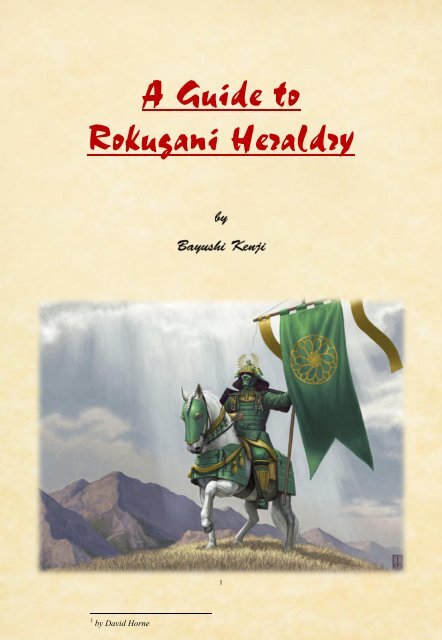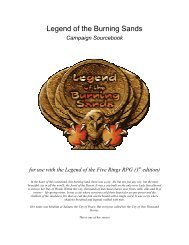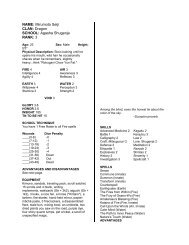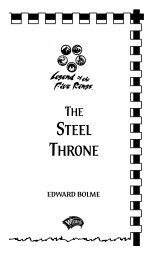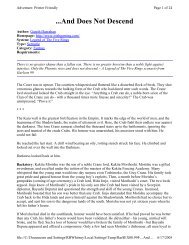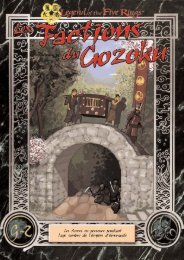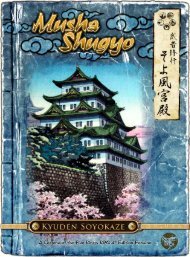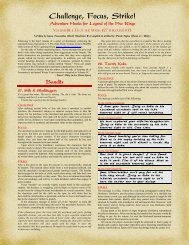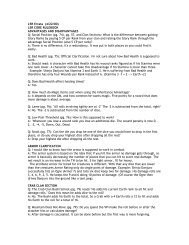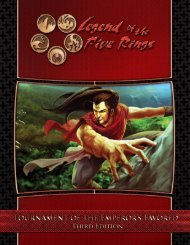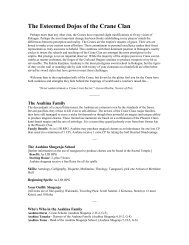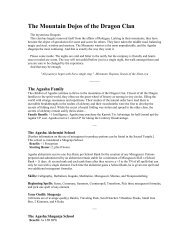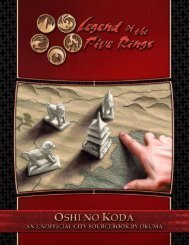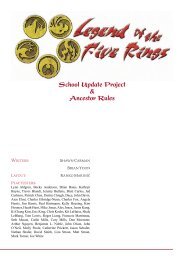Rokugan's Guide to Mon Heraldry - Kaze no Shiro
Rokugan's Guide to Mon Heraldry - Kaze no Shiro
Rokugan's Guide to Mon Heraldry - Kaze no Shiro
You also want an ePaper? Increase the reach of your titles
YUMPU automatically turns print PDFs into web optimized ePapers that Google loves.
A <strong>Guide</strong> <strong>to</strong><br />
Rokugani <strong>Heraldry</strong><br />
1 by David Horne<br />
1
<strong>Heraldry</strong> in Rokugan is less formal than heraldry in the West. All samurai<br />
sworn <strong>to</strong> a Clan wear the mon, or Clan symbols and colours. Nobles often wear a<br />
kamishimo or small vest over the kimo<strong>no</strong> that bears the mon, on formal occasions.<br />
A samurai wear his Clan’s mon the back, and the mon of his Family on his left<br />
sleeve close <strong>to</strong> his heart, or his right sleeve <strong>to</strong> guide his sword.<br />
A samurai usually incorporates his Clan’s colours in<strong>to</strong> his formal clothing;<br />
private clothing tends <strong>to</strong> be drab grays and browns. Samurai often wear hats for<br />
formal occasions, which can be very simple or very extravagant, depending upon<br />
the wearer’s mood.<br />
<strong>Heraldry</strong> can be broken by Clan, Family, house and individual. Typically,<br />
heraldry is done by a combination of two colours: a dark, and a light. The crest of<br />
the Family is a simple, elegant design intended <strong>to</strong> symbolically identify that house<br />
within the Great Clan <strong>to</strong> which it owes fealty. Usually, the colours are the same as<br />
the Clan’s, differing only in intensity and hue. Each major Family has its own mon,<br />
and each vassal Family has a variation of that major Family’s mon. This can<br />
become extremely complex, particularly for a courtier who attempts <strong>to</strong> determine if<br />
an approaching bad of bushi are friend or foe.<br />
Many of the motifs represented in the mon are based on nature, particularly<br />
animals with which the Clan identifies <strong>to</strong> (the Crab, the Scorpion, etc.). The<br />
Imperial mon is the Chrysanthemum, and only members of the direct Hantei line<br />
may wear that particular crest. Other representatives of the Emperor wear the crest<br />
of his Emerald Champion, the laurel wreath.<br />
The Imperial Court often flies flags over the current residence of the<br />
Emperor, <strong>to</strong> show his authority. These flags, k<strong>no</strong>wn as ban, bear the Imperial mon,<br />
followed by the mon of the Clan and Family hosting the Emperor.<br />
A<strong>no</strong>ther type of ban is the smaller, rectangular-shaped banners carried<br />
during travel, or on the field. These ban, k<strong>no</strong>wn as hata, are the source of the<br />
respected office of hatamo<strong>to</strong>, or “banner bearers”, for such advisors carry of the<br />
daimyo’s words <strong>to</strong> the rest of his Clan.<br />
It is <strong>no</strong>t unusual for a samurai <strong>to</strong> be granted his own mon by his daimyo.<br />
Such things arise for <strong>no</strong>table ho<strong>no</strong>ur or courage, and are <strong>no</strong>t passed from father <strong>to</strong><br />
son. To be granted one’s own mon is a personal ho<strong>no</strong>ur, one which speaks highly<br />
of the samurai. If the samurai is particularly impressive, the mon may be extended<br />
<strong>to</strong> his house, and from there, <strong>to</strong> any vassals the samurai procures.
Example: If you were <strong>to</strong> see the mon of a lesser samurai, Shosuro Juti, it<br />
might follow this format: The <strong>to</strong>p of his banner displays the mon of his Clan (the<br />
Scorpion). Juti’s own kimo<strong>no</strong> would represent the colours and mon of his house,<br />
the Shosuro. If a viewing courtier looked more closely, she would <strong>no</strong>tice a smaller<br />
mon on the sleeve of his kimo<strong>no</strong> that stated his name (Juti). 2<br />
The mon is <strong>no</strong>t just the symbol of the people currently in the Clan. It also<br />
represents the souls of all the ances<strong>to</strong>rs of the Clan, and therefore the mon should<br />
never be treated with disrespect. To do so would insult all the ances<strong>to</strong>rs of that<br />
house or Family.<br />
When a samurai wears the mon of his Clan he always wears it on his back<br />
as a gesture of respect. The Family mon can be worn over the left shoulder so his<br />
ances<strong>to</strong>rs are closer <strong>to</strong> his heart or over the right shoulder so they can guide his<br />
sword arm. 3<br />
The general Sun Tao once said that when a samurai sees himself<br />
surrounded by a sea of his Clan’s colours, he can<strong>no</strong>t fail, and when he sees the<br />
horizon blanketed in a sea of his enemy’s colours, he truly k<strong>no</strong>ws defeat. It is thus<br />
that every Great and Mi<strong>no</strong>r Clan has colours that symbolize membership in their<br />
Clan. A samurai’s armour will always be crafted in the colours of his Clan, as will<br />
most of his courtly attire. While it is <strong>no</strong>t expressly forbidden for a samurai <strong>to</strong> wear<br />
other colours in more casual settings, most wear their Clan’s colours as often as<br />
possible as a sign of loyalty. 4<br />
2 Winter Court - Kyuden Seppun, p. 57-58<br />
3 Way of the Crane, p. 22<br />
4 Legend of the Five Rings 3 rd Edition revised core rulebook, p. 72
5 by Jason Engle<br />
5
Sources and Credits<br />
Sources and Explanations<br />
This document is a fan-made supplement for the Legend of the Five Rings<br />
setting. While it is <strong>no</strong>t official all the information, save the introduc<strong>to</strong>ry texts, is<br />
ca<strong>no</strong>n and referenced.<br />
This document is a compilation of information on heraldry. <strong>Heraldry</strong> is <strong>no</strong>t<br />
just mon and chops. It is also about colours, shapes and words. <strong>Mon</strong> are the<br />
immerged part of the iceberg, but there are numerous ways <strong>to</strong> properly show, and<br />
discover, one’s allegiance. The intent of this document is <strong>to</strong> show all aspects of<br />
Rokugani heraldry. All pictures present an iconic aspect of heraldry in Rokugan, be<br />
it a banner, armour or kimo<strong>no</strong>.<br />
The text information is from, in <strong>no</strong> particular order: the “Way of”<br />
clanbooks (Crab, Crane, Dragon, Lion, Phoenix, Scorpion, Unicorn, Mi<strong>no</strong>r Clans,<br />
Shadowlands, Brotherhood of Shinsei and Wolf), “Secrets of the Crab”, “Secrets of<br />
the Dragon”, “Legend of the Five Rings 3 rd Edition revised core rulebook”,<br />
“Bearers of Jade”, “Winter Court - Kyuden Seppun”, “Way of the Shugenja”,<br />
“Way of the Samurai” and from the fiction “To Change the World” by Rich Wulf.<br />
The art in this file are the sole property of Alderac Entertainment Group<br />
and their authors: Chris<strong>to</strong>pher Appel, Steve Argyle, Drew Baker, Miguel Coimbra,<br />
Edwin David, John Donahue, Jason Engle, David Horne, Ijur, Jaime Jones, Okita<br />
and Bagus Hu<strong>to</strong>mo<strong>to</strong> from Imaginary Friends Studios, Michael Komarck,<br />
Lasahido, April Lee, Glen Osterberger, Terekjet, Charles Urbach and Mario<br />
Wibiso<strong>no</strong>. Art pieces have a link <strong>to</strong> their Internet location or at least <strong>to</strong> the artist’s<br />
website when pin-pointing was <strong>no</strong>t possible the piece.<br />
The pictures of mon in this document are from four different websites:<br />
Heroes of Rokugan, The Jade Hand, Evan’s Ville Gaming Guild and L5RWikia,<br />
and an artist SpookyElectric. A few mon are personal creations.
In accordance with the timeline neutrality approach of the 4 th Edition of the<br />
Legend of the Five Rings role-playing game, choices were made:<br />
The old Hiruma Family is considered gone with the death of Hiruma<br />
Sokokai and the loss of the advanced techniques of the Hiruma Family, in 755 of<br />
the Isawa calendar; the Hiruma Castle fell <strong>to</strong> the Shadowlands in 716.<br />
The Yasuki Family is associated <strong>to</strong> both the Crab and Crane Clan, each<br />
Clan getting a specific version.<br />
The Mi<strong>no</strong>r Clans who joined a Great Clan: Centipede, Falcon, Fox and<br />
Wasp, are recorded with the Great Clan they joined but get a double title, as<br />
Family and Mi<strong>no</strong>r Clan.<br />
The Agasha Family is presented in both Dragon and Phoenix Clans. The<br />
Utaku and Otaku Family are one Family section.<br />
The Spider are <strong>no</strong>t considered a Great Clan yet, however that should be<br />
changing soon because of the MegaGame; once it is done, and when Spider<br />
Families get a mon, the changes will be applied.<br />
Colours of the mon may vary, depending on the book and the edition, when<br />
that is the case, both versions are presented.<br />
The black and white mon are for viewers <strong>to</strong> express their artistic vibes and<br />
create their own.<br />
It has <strong>to</strong> be <strong>no</strong>ted that some mon from Wikia are <strong>no</strong>n-ca<strong>no</strong>n representations.<br />
They use approximations of the design and different colours than those appearing<br />
or mentioned in the books. They are presented only <strong>to</strong> offer an alternative.
Credits and Contribu<strong>to</strong>rs<br />
The first thanks goes <strong>to</strong> the Legend of the Five Rings S<strong>to</strong>ry and Design<br />
Teams, for making Rokugan setting so rich we have <strong>to</strong> compile information <strong>no</strong>t <strong>to</strong><br />
get lost in it.<br />
A big thanks <strong>to</strong> Kakita Seigi and his website <strong>Kaze</strong> <strong>no</strong> <strong>Shiro</strong>, for hosting my<br />
files; the title of the document is his idea.<br />
Special thanks <strong>to</strong> Okuma, for finding obscure and hidden information<br />
where <strong>no</strong> man had ever been before; the “Dojo and Holdings” section is<br />
shamelessly based upon his own work about heraldry in Rokugan.<br />
A design thanks <strong>to</strong> jim pin<strong>to</strong>, for his insightful feedback.<br />
Thank you SpookyElectric, for giving me permission <strong>to</strong> add your mon art.<br />
Thanks <strong>to</strong> Alderac Entertainment Group, for letting me use the art.<br />
A final thanks <strong>to</strong> the artists, for, well, the art.
Table of Contents<br />
A <strong>Guide</strong> <strong>to</strong> Rokugani <strong>Heraldry</strong> 1<br />
Sources and Credits 4<br />
Sources and Explanations 4<br />
Credits and Contribu<strong>to</strong>rs 6<br />
Table of Contents 7<br />
<strong>Mon</strong>s and Colours 11<br />
The Crab 12<br />
Crab Clan 14<br />
Hida Family 14<br />
Hiruma Family 15<br />
Kaiu Family 16<br />
Kuni Family 16<br />
Yasuki Family 17<br />
Toritaka Family and Falcon Clan 17<br />
The Crane 18<br />
Crane Clan 20<br />
Doji Family 20<br />
Kakita Family 21<br />
Asahina Family 21<br />
Daidoji Family 22<br />
Yasuki Family 23<br />
The Dragon 24<br />
Dragon Clan 26<br />
Togashi Family 26<br />
Mirumo<strong>to</strong> Family 27<br />
Agasha Family 27<br />
Kitsuki Family 28<br />
Hi<strong>to</strong>mi Family 28<br />
Hoshi Family 29<br />
Tamori Family 29
The Lion 30<br />
Lion Clan 32<br />
Akodo Family 32<br />
Matsu Family 33<br />
Ikoma Family 33<br />
Kitsu Family 34<br />
The Mantis 35<br />
Mantis Clan and Yori<strong>to</strong>mo Family 37<br />
Tsuruchi Family and Wasp Clan 37<br />
Moshi Family and Centipede Clan 37<br />
Kitsune Family and Fox Clan 38<br />
The Phoenix 39<br />
Phoenix Clan 41<br />
Shiba Family 41<br />
Isawa Family 42<br />
Asako Family 43<br />
Agasha Family 44<br />
The Scorpion 45<br />
Scorpion Clan 47<br />
Bayushi Family 47<br />
Shosuro Family 48<br />
Soshi Family 48<br />
Yogo Family 49<br />
The Unicorn 50<br />
Unicorn Clan 52<br />
Shinjo Family 52<br />
Utaku and Otaku Family 53<br />
Iuchi Family 53<br />
Ide Family 54<br />
Mo<strong>to</strong> Family 55<br />
Horiuchi Family 56<br />
Imperial 57<br />
The Emperor 59
O<strong>to</strong>mo Family 59<br />
Seppun Family 59<br />
Miya Family 60<br />
Emerald Champion and Emerald Magistrates 60<br />
Jade Champion and Jade Magistrates 60<br />
Yotsu Family 61<br />
Mi<strong>no</strong>r Clans 62<br />
Badger Clan 64<br />
Bat Clan 64<br />
Boar Clan 64<br />
Dragonfly Clan 65<br />
Hare Clan 65<br />
<strong>Mon</strong>key Clan 65<br />
Ox Clan 66<br />
Snake Clan 66<br />
Sparrow Clan 66<br />
Tor<strong>to</strong>ise Clan 67<br />
Other Factions 68<br />
The Brotherhood of Shinsei 70<br />
Toturi’s Army and Legion of the Wolf 70<br />
The Jade Hand 70<br />
Nezumi and One Tribe 71<br />
The Naga 71<br />
Shadowlands Horde 72<br />
The Mo<strong>to</strong> Black Guard 72<br />
The Spider 73<br />
Dojo and Holdings 74<br />
The Crab 75<br />
Kuni Wastes 75<br />
The Witch Hunters 77<br />
The Damned 78<br />
The Crane 80<br />
Kyuden Doji 80
Kakita Duelling Academy 80<br />
Kosaten <strong>Shiro</strong> 80<br />
The Dragon 81<br />
Mountain Home Dojo 81<br />
Togashi Testing Grounds 81<br />
The Lion 82<br />
<strong>Shiro</strong> No Yojin 82<br />
The Mantis 83<br />
Dojo Raiden 83<br />
The Phoenix 84<br />
Asako Inquisi<strong>to</strong>rs 84<br />
The Scorpion 86<br />
Dojo of Lies 86<br />
Dojo of the Closed Eye 86<br />
The Unicorn 87<br />
Gatherer of Winds Dojo 87
<strong>Mon</strong>s and Colours<br />
This section is the most prominent of the document, as mon account for the<br />
biggest part of Rokugani heraldry. However, as titled, official Clans’ and Families’<br />
colours are in it <strong>to</strong>o, and for Families or Clans having one; mot<strong>to</strong>s are also<br />
presented.<br />
Each mon has a particular significance and his<strong>to</strong>ry. Some are k<strong>no</strong>wn<br />
Empire-wide, such as the Emperor’s mon and the Isawa mon, others are so obscure<br />
they have gone forgotten, but every mon means the world <strong>to</strong> the Clan and Family<br />
members who wear it.<br />
Colours are primarily important for clothing, as samurai make a habit of<br />
wearing their Clan’s colours, especially in formal setting. Also, Families’ and<br />
Clan’s colours do <strong>no</strong>t always match, even though, more often than <strong>no</strong>t, Families<br />
use at least one colour from the Clan mon.<br />
6 by Bagus Hu<strong>to</strong>mo<strong>to</strong><br />
6
7 by Michael Komarck<br />
8 by Miguel Coimbra<br />
7<br />
8
9 by Steve Argyle<br />
10 by Miguel Coimbra<br />
9<br />
10
Crab Clan<br />
Gunmetal-grey, blue and brick red. 11<br />
Hida Family<br />
All Crab families, with the exception of the Yasuki, integrate the image of a<br />
crab in<strong>to</strong> their mon – reflecting their position in a larger entity and their<br />
responsibilities <strong>to</strong> that entity.<br />
The Hida mon depicts a blue crab on a field of slate-grey, clutching a<br />
tetsubo in its pincers. It signifies both the Family’s great strength and their duties<br />
as sentinels for the Emperor. 12<br />
11 Legend of the Five Rings 3 rd Edition revised core rulebook, p. 72<br />
12 Way of the Crab, p. 36
Hiruma Family<br />
“A single fire against the darkness always burns brightest”<br />
Since the Hiruma have taken back their ancestral lands, they <strong>no</strong> longer feel<br />
a burning shame attached <strong>to</strong> their Family name. Thus, they have adopted a crest<br />
and mot<strong>to</strong> for their children <strong>to</strong> pass down the generations that symbolizes their<br />
place in the Empire. 13<br />
From the year 755 <strong>to</strong> the year 1130<br />
No mon. No saying. The Hiruma do <strong>no</strong>t live so long as their land is gone. 14<br />
Bearers of Jade<br />
Old Hiruma<br />
13 Secrets of the Crab, p. 36<br />
14 Way of the Crab, p. 38<br />
15 The old mon of the Hiruma Family can be seen on the back of a samurai, on page 58 of<br />
15
Kaiu Family<br />
The Kaiu mon represents their sturdiness and position as the great<br />
foundation of the Clan. It portrays the blood-red claw of a crab, surrounded by<br />
bricks, on a field of white. The bricks represent protectiveness a shield against<br />
danger, while the claw represents hidden weapons, striking if their defence is ever<br />
breached. 16<br />
Kuni Family<br />
The Kuni mon is a pair a red crab claws over a cream-colored field and<br />
surrounded by a circle of blue. It represents the Kuni’s search for the great<br />
mysteries of the universe, and reminds them that such mysteries may often be<br />
found within themselves. 17<br />
16 Way of the Crab, p. 39<br />
17 Way of the Crab, p. 41
Yasuki Family<br />
“May your cup always be full, and hands never be empty.”<br />
The Yasuki mon is a stark contrast <strong>to</strong> the other Crab families. It depicts a<br />
golden carp surrounding a flower of deep azure. The car is considered an animal of<br />
good fortune, and the mon is intended <strong>to</strong> bring wealth and prosperity <strong>to</strong> all the<br />
Yasuki under it. 18<br />
Toritaka Family and Falcon Clan<br />
Dark gray and forest-green. 19<br />
18 Way of the Crab, p. 44<br />
19 Way of the Mi<strong>no</strong>r Clans, p.3
20 by Steve Argyle<br />
21 by Okita<br />
20<br />
21
22 by Steve Argyle<br />
23 by Edwin David<br />
22<br />
23
Sky-blue and white. 24<br />
Crane Clan<br />
Doji Family<br />
“Be more concerned with good actions than with great ones.”<br />
A crane holding an eight-pointed s<strong>no</strong>wflake in its beak.<br />
The words which are the mot<strong>to</strong> of the Doji Family where the last spoken by<br />
Lady Doji on the night of her death. It is said she came <strong>to</strong> the bedside of Doji<br />
Ochiba, Doji Nio’s wife, and revealed her several secrets of the Doji’s household<br />
which have been passed down from each Crane’s daimyo’s wife <strong>to</strong> her successor. 25<br />
26<br />
24 Legend of the Five Rings 3 rd Edition revised core rulebook, p. 72<br />
25 Way of the Crane, p. 24<br />
26 by SpookyElectric
Kakita Family<br />
“For the coward there is <strong>no</strong> life. For the hero there is <strong>no</strong> death.”<br />
A crane’s wing, outstretched around an unsheathed katana.<br />
The unsheathed katana is the symbol of war, and <strong>to</strong> the Kakita Family it is<br />
also a reminder that they must always be ready <strong>to</strong> defend the Crane house and<br />
Imperial line from their enemies. For a thousand years, Kakita’s treatise, The<br />
Sword, has been one of two predominant works on swordplay, and is taught in<br />
nearly every school of bushido in Rokugan. 27<br />
27 Way of the Crane, p. 28
Asahina Family<br />
“K<strong>no</strong>wledge must be earned, <strong>no</strong>t simply learned.”<br />
A crane’s head, holding in its beak a peach blossom.<br />
The peach tree is the primary wood used in the creation of fetishes and<br />
nemuranai, and is used by the Asahina for many things. Because it is so integral <strong>to</strong><br />
their work, there are tremendous peach trees which line the road <strong>to</strong> the Asahina<br />
temple. The peach blossom itself is the sign of change and of peace – two things<br />
the Asahina wish their work <strong>to</strong> epi<strong>to</strong>mize. 28<br />
28 Way of the Crane, p. 35
Daidoji Family<br />
“The spear waits <strong>no</strong>t for his master, but rushes forth <strong>to</strong> guard the way.” 29<br />
A crane, wings outstretched above a snake, wrapped about a yari.<br />
The Daidoji respect the spear as a weapon, and many of their bushi learn <strong>to</strong><br />
use a yari before they learn <strong>to</strong> use a katana. Their creed speaks of their readiness <strong>to</strong><br />
leap <strong>to</strong> the defence of the Crane – both in military and other matters. A Daidoji<br />
bushi has his Clan’s mon tat<strong>to</strong>oed on his wrists on the day on his gempukku, <strong>to</strong><br />
remind him of his sworn duty <strong>to</strong> the Crane.<br />
29 Way of the Crane, p. 42
Yasuki Family<br />
Old Yasuki<br />
“May your cup always be full, and hands never be empty.” 30<br />
A crane with a chrysanthemum.<br />
This was the mon of the Yasuki before their break from the Crane Clan.<br />
Since then, their mon has been changed <strong>to</strong> reflect their new position within the<br />
Crab Clan, but the original Yasuki mon can still be found on ancient items. Many<br />
of these items were destroyed – either by the Yasuki themselves or by the Daidoji<br />
– but some few remain. They are considered very bad luck <strong>to</strong> the Yasuki; if at any<br />
time one is brought within the walls of the Black Crane palace, it is said <strong>to</strong> bring a<br />
year of bad trade and ill fortune.<br />
30 Way of the Crane, p. 47
31 by Edwin David<br />
32 by April Lee<br />
31<br />
32
33 by Edwin David<br />
34 by Miguel Coimbra<br />
33<br />
34
Emerald-green and yellow. 35<br />
Dragon Clan<br />
Togashi Family<br />
The mon of the Togashi Family is a dragon encircling and holding a plum<br />
blossom. When Togashi broke his fast after Shinsei’s famous words – “neither will<br />
I”, it was a plum that fell in<strong>to</strong> Togashi’s hand for him <strong>to</strong> eat. 36<br />
These monks follow the teachings of Togashi, Kami and founder of the<br />
Dragon Clan. They embrace a philosophy of enlightenment through spontaneity,<br />
and value, humility, compassion, and a sense of humor. 37<br />
35 rd<br />
Legend of the Five Rings 3 Edition revised core rulebook, p. 72<br />
36<br />
Way of the Dragon, p. 18<br />
37<br />
Secrets of the Dragon, p. 69
Mirumo<strong>to</strong> Family<br />
The mon of the Mirumo<strong>to</strong> Family is dragon encircling and holding a<br />
daisho. For a thousand years, the Mirumo<strong>to</strong> samurai have employed their<br />
patriarch’s technique, and it is recognized, if <strong>no</strong>t respected, across Rokugan. 38<br />
Agasha Family<br />
The mon of the Agasha Family is a dragon encircling and clinging <strong>to</strong> a<br />
pomegranate. On the outside, the pomegranate is simple, appearing <strong>to</strong> be an<br />
ordinary fruit like an apple or pear. Once opened, it reveals its many, many seeds,<br />
all of which represent a separate possibility, a hundred different potentialities. 40<br />
38 Way of the Dragon, p. 24<br />
39 by SpookyElectric<br />
40 Way of the Dragon, p. 30<br />
39
Kitsuki Family<br />
The mon of the Kitsuki Family is a dragon encircling and clinging <strong>to</strong> a<br />
lightning bolt. The image is a curious one. The Kitsuki’s representation of<br />
lightning is like a swirling maze. Lightning cuts through the darkness, revealing<br />
what could <strong>no</strong>t be seen before, and is representative of Osa<strong>no</strong>-Wo, the Thunderer,<br />
who brings the wrath of the gods <strong>to</strong> those whose deserve justice. 41<br />
Hi<strong>to</strong>mi Family<br />
The Order of Hi<strong>to</strong>mi is the most feared and misunders<strong>to</strong>od of the Three<br />
Orders. They follow the teachings of Hi<strong>to</strong>tni, Lady Moon, the Dragon Thunder.<br />
They embrace the philosophy of attaining enlightenment through physical and<br />
mental hardship. Members of this order seek out impossible challenges through<br />
which <strong>to</strong> prove their worth, and as a result the Hi<strong>to</strong>mi have a reputation for<br />
violence. 42<br />
43<br />
41 Way of the Dragon, p. 32<br />
42 Secrets of the Dragon, p. 70<br />
43 by SpookyElectric
Hoshi Family<br />
The Hoshi are the smallest of the Three Orders. They embrace a philosophy<br />
of enlightenment through balance and moderation. They see the Togashi and the<br />
Hi<strong>to</strong>mi as the embodiment of dissonance, and maintaining harmonious relations<br />
between the two families is their greatest challenge. To the Hoshi, patience is the<br />
greatest of all virtues. Power, wisdom, and all other virtues are of little worth if one<br />
can<strong>no</strong>t master patience. 44<br />
44 Secrets of the Dragon, p. 70<br />
Tamori Family
45 by Edwin David<br />
46 by Terekjet<br />
45<br />
46
47 by Steve Argyle<br />
48 by Steve Argyle<br />
47<br />
48
Gold and earth <strong>to</strong>nes. 49<br />
Lion Clan<br />
Akodo Family<br />
The Akodo mon is a lion’s face, full of dedication. It is a sharp contrast <strong>to</strong><br />
the blunt fury of the Matsu mon; the division of the face presents the Akodo’s dual<br />
nature, as both accomplished warriors and learned thinkers. 50<br />
49 Legend of the Five Rings 3 rd Edition revised core rulebook, p. 72<br />
50 Way of the Lion, p. 22
Matsu Family<br />
The Matsu mon was crafted with their simple passion for war in mind. It<br />
shows a sword, carried in a lion’s paw, raised <strong>to</strong> the heavens in defiance of any<br />
who would challenge them. 51<br />
Ikoma Family<br />
The Ikoma mon is an arched portal surrounding <strong>no</strong>thing. Though others<br />
may see the Lion ico<strong>no</strong>graphy upon it as more important, all Ikoma realize the<br />
importance of the portal itself. Through each portal lies k<strong>no</strong>wledge and ultimate<br />
understanding, along with a<strong>no</strong>ther portal and a greater vista. The path <strong>to</strong><br />
comprehension is never-ending, as each discovery leads <strong>to</strong> more questions. 52<br />
51 Way of the Lion, p. 33<br />
52 Way of the Lion, p. 38<br />
53 by SpookyElectric<br />
53
Kitsu Family<br />
The Kitsu mon bears a striking resemblance <strong>to</strong> their fallen ances<strong>to</strong>r, before<br />
he was made by Lady Sun <strong>to</strong> look like men. Kitsu remember the past, those who<br />
have come before, and what they have done. Their mon is a memory, both of fallen<br />
Kitsu and his legacy. 54<br />
54 Way of the Lion, p. 43
55 by Michael Komarck<br />
56 by Chris Appel<br />
55<br />
56
57 by Edwin David<br />
58 by Steve Argyle<br />
57<br />
58
Mantis Clan and Yori<strong>to</strong>mo Family<br />
Sea-green and black. 59<br />
Teal-green and gold. 60<br />
Tsuruchi Family and Wasp Clan<br />
Black and gold. 61<br />
59 Legend of the Five Rings 3 rd Edition revised core rulebook, p. 72<br />
60 Way of the Mi<strong>no</strong>r Clans, p.3<br />
61 Way of the Mi<strong>no</strong>r Clans, p.3
Moshi Family and Centipede Clan<br />
Orange, black and brown. 62<br />
Kitsune Family and Fox Clan<br />
Red-brown and silver. 63<br />
62 Way of the Mi<strong>no</strong>r Clans, p.3<br />
63 Way of the Mi<strong>no</strong>r Clans, p.3
64 by Mario Wibisi<strong>no</strong><br />
65 by Michael Komarck<br />
64<br />
65
66 by Jason Engle<br />
67 by Steve Argyle<br />
66<br />
67
Red, yellow and orange. 68<br />
Phoenix Clan<br />
68 Legend of the Five Rings 3 rd Edition revised core rulebook, p. 72
Shiba Family<br />
The mon of the Shiba Family is a set of crossed swords, surmounted by the<br />
flames of the Phoenix. While the background is a s<strong>to</strong>ic black, the flames and<br />
swords are done in vibrant gold and silver, symbolizing the eternal dedication of<br />
the Shiba <strong>to</strong> their founder’s oath. There is a variant of the Shiba mon which is used<br />
by those bushi who serve Isawa shugenja as yojimbo – the central area between the<br />
swords then also contains the symbol of Void, stitched in shining gold. 69<br />
69 Way of the Phoenix, p. 37<br />
Shiba Yojimbo
Isawa Family<br />
The mon bears the symbol of the Five Elements, symbolizing the arcane<br />
ties which the Isawa have <strong>to</strong> the kami. The spiral pattern indicates their belief that<br />
all things in nature are part of each other, bound by the fabric of eternity.<br />
The mon of the Isawa may be the most widely k<strong>no</strong>wn Family symbol in the<br />
Empire, save only that of Hantei himself. Certainly it is worn by hundreds of<br />
shugenja in all the Clans of Rokugan, showing their ties <strong>to</strong> the teachers of<br />
spellcraft. Students who graduate from the Isawa schools, and even those who<br />
simply for a few years after their graduation from the schools of other Clans, wear<br />
the mark as a badge of pride. 70<br />
Much <strong>to</strong> Temoru's shock, the symbol adorning the City of Gold was <strong>no</strong>t the<br />
chop of Isawa as he had believed. Instead, the information he uncovered there<br />
indicated that Isawa may have been born within the city and adopted its symbol as<br />
his own when he left for Rokugan. 71<br />
70 Way of the Phoenix, p. 23<br />
71 Secrets of the Dragon, p. 41
Asako Family<br />
The mon of the Asako is comprised of a simple hand, holding a quill. The<br />
quill ends in flames symbolizing the Phoenix for whom the Family serves; the quill<br />
itself is the sign of their devotion as his<strong>to</strong>rians and keepers of information. Asako<br />
once used a<strong>no</strong>ther mon – one with far more sinister over<strong>to</strong>nes – but if it is true,<br />
then that mon was lost long ago. 72<br />
Old Asako<br />
The first man who had spoken was called Sagoten, a<strong>no</strong>ther of the many<br />
who created me. He bore the name of his mother, Asako. The symbol on his chest<br />
was that of an open hand, the fingers stained in blood, the symbol his father created<br />
<strong>to</strong> symbolize his family’s dedication <strong>to</strong> the magic Isawa taught them. That symbol<br />
has long been forgotten. I wonder why? 73<br />
72 Way of the Phoenix, p. 43<br />
73 the old mon of the Asako Family is depicted in the fiction “To Change the World”
Agasha Family<br />
The mon of the Agasha Family is a dragon encircling and clinging <strong>to</strong> a<br />
pomegranate. On the outside, the pomegranate is simple, appearing <strong>to</strong> be an<br />
ordinary fruit like an apple or pear. Once opened, it reveals its many, many seeds,<br />
all of which represent a separate possibility, a hundred different potentialities. 74<br />
74 Way of the Dragon, p. 30
75 by Miguel Coimbra<br />
76 by Edwin David<br />
75<br />
76
77 by Michael Komarck<br />
78 by Miguel Coimbra<br />
77<br />
78
Blood-red and black. 79<br />
Scorpion Clan<br />
Bayushi Family<br />
The mon of the Bayushi Family is a scorpion surrounded by water. It is<br />
often accompanied by the kanji “I can swim”. 80<br />
79 rd<br />
Legend of the Five Rings 3 Edition revised core rulebook, p. 72<br />
80<br />
Way of the Scorpion, p. 24
Shosuro Family<br />
The mon of the Shosuro is an endless loop of intertwining ivy. It is the<br />
eternal maze, the puzzle that may never be solved. 81<br />
Soshi Family<br />
The mon of the Soshi Family is a scorpion with claws outstretched, a net<br />
between them. 82<br />
81 Way of the Scorpion, p. 28<br />
82 Way of the Scorpion, p. 29
Yogo Family<br />
The mon of the Yogo Family is a mask made of flaming feathers,<br />
representing their lost heritage <strong>to</strong> the Phoenix Clan. 83<br />
83 Way of the Scorpion, p. 33
84 by Steve Argyle<br />
85 by Lasahido<br />
84<br />
85
86 by Miguel Coimbra<br />
87 by Drew Baker<br />
86<br />
87
Purple and white. 88<br />
Unicorn Clan<br />
When the Unicorn meet with outsiders, they tend <strong>to</strong> use the Unicorn mon.<br />
However, in the Unicorn Clan, each Family has its own mon. A Family’s mon is<br />
most often prominently displayed during Unicorn Clan gatherings. Finally, each<br />
person or nuclear family within the Clan may have their own mon. Usually this is<br />
simply the kanji character of their name, but other symbols have been used, and are<br />
<strong>to</strong>o numerous <strong>to</strong> be listed here. 89<br />
88 Legend of the Five Rings 3 rd Edition revised core rulebook, p. 72<br />
89 Way of the Unicorn, p. 35
Shinjo Family<br />
The Ki-Rin design in the Shinjo mon, is regarded by the Family as a<br />
portrait of the original Shinjo in her true form. The Ki-Rin faces West, representing<br />
Shinjo’s journey in<strong>to</strong> that mysterious land. The flaming mane is swept back as the<br />
creature runs free, a symbol of the Family’s spirit of freedom and exploration. The<br />
colour scheme is black on bright orange, with fiery red around the edge. 90<br />
Utaku and Otaku Family<br />
The Otaku mon is the simplest of Rokugan: a plain field of pale purple. It<br />
represents the original Otaku’s silence, but can also be taken <strong>to</strong> represent her purity<br />
of purpose. Many opponents, have learned, in some cases quite briefly, how<br />
terrifying this banner can be when carried by a formation of charging, silent<br />
shio<strong>to</strong>me, <strong>no</strong>ne of whom wish <strong>to</strong> disho<strong>no</strong>ur their ances<strong>to</strong>r by uttering a battle cry. 91<br />
90 Way of the Unicorn, p. 44<br />
91 Way of the Unicorn, p. 42
Iuchi Family<br />
Power is what you think it is.<br />
The mon of the Iuchi Family clearly represents their devotion <strong>to</strong> the study<br />
of magic. An open scroll flows across a deep blue field. The spirals incorporated in<br />
the design represent the dynamic, fluid energy of magic, while the scroll<br />
symbolises the Tao of Shinsei, on which the Iuchi base all their magical<br />
interpretations. 92<br />
92 Way of the Unicorn, p. 41
Ide Family<br />
“Violence is the language of defeat, swords the <strong>to</strong>ngues of the lost.”<br />
- from the Ide Family standard banner<br />
The Ide Family mon shows a gold-coloured hand open in friendship and<br />
giving. The green octagon that forms the background represents the Emerald<br />
Empire and the eight children who founded it. There is a variant of the Ide mon<br />
also in use: those of the Family who choose <strong>to</strong> pursue magic (or, more rarely, war)<br />
display the Ide mon with the fingers pointing up, as if it were poised <strong>to</strong> deliver a<br />
jiujutsu strike. 93<br />
93 Way of the Unicorn, p. 40<br />
Non-courtier Ide
Mo<strong>to</strong> Family<br />
“Mo<strong>to</strong> can die, but can<strong>no</strong>t yield.”<br />
- from the Mo<strong>to</strong> war banner, during the Blood War<br />
“Never.”<br />
- from the Mo<strong>to</strong> war banner, present day<br />
The mon of the Mo<strong>to</strong> Family bears the face of death – a stylized mask of<br />
intimidating determination that matches the ghostly white make-up worn by the<br />
Mo<strong>to</strong> samurai in<strong>to</strong> battle. The mon is stark and grim, as the Mo<strong>to</strong> are themselves,<br />
and its appearance on the battlefield always seems <strong>to</strong> be followed by a<br />
disconcerting chill and a mournful keening of the wind.<br />
The Mo<strong>to</strong> wear white armour with purple used only as highlights.<br />
The loss of their Family’s ho<strong>no</strong>ur through the vile sorceries of the<br />
Shadowlands has had a profound effect on the remainder of the Mo<strong>to</strong> Family. They<br />
changed their Family mon <strong>to</strong> reflect their change of attitude. Instead of the<br />
optimistic red chrysanthemum, their new banner bore a grim and threatening<br />
kabuki face; and they replaced the mot<strong>to</strong> on their war banner.<br />
In spite of their grievous losses during the Blood War, the Family has<br />
rebuilt. They have formed the White Guard, a military unit that embodies the<br />
implacable determination and unyielding mettle of the Family.<br />
Their armour is white and battered, ghostly white plumes and manes adorn<br />
their helmets, and their faces are painted with stark white and black in frightening<br />
masks of death. 94<br />
94 Way of the Unicorn, p. 44 <strong>to</strong> 46
Old Mo<strong>to</strong>
Horiuchi Family<br />
95<br />
95 a mon can be seen on the “Shinden Horiuchi” card, however it is unclear if it is a<br />
stylised Unicorn mon or the Horiuchi Family mon; the former is more likely
96 by Steve Argyle<br />
97 by April Lee<br />
96<br />
97
98 by April Lee<br />
99 by Chris Appel<br />
98<br />
99
The Emperor<br />
O<strong>to</strong>mo Family
100<br />
100 by SpookyElectric<br />
Seppun Family<br />
Miya Family
Emerald Champion and Emerald Magistrates<br />
101<br />
Jade Champion and Jade Magistrates<br />
101<br />
the mon of the Emerald Champion and Magistrates can be seen on the<br />
“Test of the Emerald Champion” card<br />
102<br />
the mon of the Jade Champion and Magistrates can be seen on the<br />
“Mantle of the Jade Champion” card<br />
102
Yotsu Family<br />
103<br />
103 a mon can be seen on “Yotsu Dojo” card, however it is unclear if it is the mon of the<br />
Yotsu Dojo or the mon of the Yotsu Family
104<br />
by Glen Osterberger<br />
105<br />
by Ijur<br />
104<br />
105
106 by Steve Argyle<br />
107 by John Donahue<br />
106<br />
107
Brown and black.<br />
Badger Clan<br />
Pale grey with stripes of black and white. 109<br />
Black. 110<br />
Bat Clan<br />
108 Legend of the Five Rings 3 rd Edition revised core rulebook, p. 72<br />
109 Way of the Mi<strong>no</strong>r Clans, p.3<br />
110 Legend of the Five Rings 3 rd Edition revised core rulebook, p. 72
Dark blue and green. 111<br />
Blue, brown and gold. 112<br />
Boar Clan<br />
Dragonfly Clan<br />
Jewel <strong>to</strong>nes, in a rainbow of colour. 113<br />
111 Way of the Mi<strong>no</strong>r Clans, p.3<br />
112 Legend of the Five Rings 3 rd Edition revised core rulebook, p. 72<br />
113 Way of the Mi<strong>no</strong>r Clans, p.3
Red and white. 114<br />
Orange and brown. 115<br />
Hare Clan<br />
<strong>Mon</strong>key Clan<br />
114 Legend of the Five Rings 3 rd Edition revised core rulebook, p. 72<br />
115 Legend of the Five Rings 3 rd Edition revised core rulebook, p. 72
Blue and black. 116<br />
Silver, black and grey-purple. 117<br />
Ox Clan<br />
Snake Clan<br />
116 Legend of the Five Rings 3 rd Edition revised core rulebook, p. 72<br />
117 Legend of the Five Rings 3 rd Edition revised core rulebook, p. 72
Shades of brown.<br />
Dun-brown and black. 119<br />
Light green and white. 120<br />
Blue-black and gold. 121<br />
Sparrow Clan<br />
Tor<strong>to</strong>ise Clan<br />
118 Legend of the Five Rings 3 rd Edition revised core rulebook, p. 72<br />
119 Way of the Mi<strong>no</strong>r Clans, p.3<br />
120 Legend of the Five Rings 3 rd Edition revised core rulebook, p. 72<br />
121 Way of the Mi<strong>no</strong>r Clans, p.3
122 by Jaime Jones<br />
123 by Steve Argyle<br />
122<br />
123
124 by Steve Argyle<br />
125 by Edwin David<br />
124<br />
125
The Brotherhood of Shinsei<br />
Toturi’s Army and Legion of the Wolf
Nezumi and One Tribe<br />
The Naga
Shadowlands Horde<br />
The newest symbol borne by the minions of darkness is the scowling oni<br />
emblazed upon Yogo Junzo’s battle standard. Junzo claims that the design of the<br />
mon came <strong>to</strong> him in a dream, a vision in which the diverse creatures of darkness<br />
were unified beneath a single leader. He call this army the Shadowlands Horde.<br />
When the true leader of the Horde returns, Yogo Junzo intends <strong>to</strong> make certain his<br />
armies are waiting. 126<br />
The Mo<strong>to</strong> Black Guard<br />
The mon of the Mo<strong>to</strong> Black Guard is a hideous caricature of the mon<br />
utilised by the Unicorn Mo<strong>to</strong>. The colours of the mon have been inverted and the<br />
kabuki’s mask trademark frown has been replaced with a sinister grin. The mon<br />
was <strong>no</strong>t created as a parody of the Mo<strong>to</strong> mon, as many believe. The two were<br />
developed independently, at the same time. The Tainted Mo<strong>to</strong> believe it signifies<br />
the brotherhood they share with their “confused brethren”. The Unicorn Mo<strong>to</strong><br />
would rather <strong>no</strong>t think about what the coincidence symbolises. 127<br />
126 Way of the Shadowlands, p. 32<br />
127 Way of the Shadowlands, p. 24
Black and white. 128<br />
The Spider<br />
The Jade Hand<br />
129<br />
128 Legend of the Five Rings 3 rd Edition revised core rulebook, p. 72<br />
129 The mon of the Jade Hand can be seen on the “Hiruma Kaikawa” card
Dojo and Holdings<br />
Unlike Clans and Families, which all follow the same pattern of mon and<br />
colours, dojo have a<strong>no</strong>ther mean for individuals <strong>to</strong> show their allegiance. Every<br />
way of ho<strong>no</strong>uring the school and sensei is unique <strong>to</strong> each schooling facility.<br />
However, Rokugani heraldry extends further than the personal display of<br />
loyalty on clothing or banners, and holdings play their own part on the heraldic<br />
scene. By having easily identifiable buildings, Clans and factions make it clear <strong>to</strong><br />
outsiders whose terri<strong>to</strong>ry it is, while strengthening the unity of those living in them.<br />
130 by Charles Urbach<br />
130
Kuni Wastes<br />
The Kuni Family practices a ritual of face painting, similar in many ways <strong>to</strong><br />
the kabuki make-up worn by many Kakita ac<strong>to</strong>rs. Under ideal circumstances, the<br />
make-up is applied each day after awakening. The methodical application of the<br />
paint can take up <strong>to</strong> an hour, as each line on the face has a meaning k<strong>no</strong>wn only <strong>to</strong><br />
the individual in question. Even the Kuni do <strong>no</strong>t k<strong>no</strong>w where this tradition<br />
originated, or what purpose it serves.<br />
Kuni shugenja show respect <strong>to</strong> their sensei’s by wearing a style of face<br />
paint similar <strong>to</strong> their sensei’s. Those familiar with Kuni heraldry can identify a<br />
Kuni’s sensei, and his sensei’s sensei, by the style of his war paint. Due <strong>to</strong> Kuni<br />
tendency <strong>to</strong> relocate children <strong>to</strong> live with their sensei from an early age, Kuni are<br />
often closer <strong>to</strong> their sensei than their parents. 131<br />
131 Way of the Shugenja, p. 22<br />
132 by David Horne<br />
132
133 by Okita<br />
134 by Steve Argyle<br />
133<br />
134
The Witch Hunters<br />
The Jade seal carried by the Kuni Witch Hunter is a combination of the<br />
crossed claws of the Kuni Family mon and the open eye of the Asako Inquisi<strong>to</strong>rs.<br />
The crossed claws represent the ever-present defense offered by the tsukai-sagasu.<br />
The open eye symbolizes the eternal vigilance of their allies, the Inquisi<strong>to</strong>rs. These<br />
seals are only carried by the Kuni, and are often enhanced by the Jade Eternal spell<br />
so that they are more difficult <strong>to</strong> corrupt. The Witch Hunters are quite unforgiving<br />
<strong>to</strong>ward the rare fools that dare <strong>to</strong> lake counterfeit Witch Hunter badges. 135<br />
135 Way of the Shadowlands, p. 31<br />
136 Way of the Shadowlands, p. 85<br />
137 Way of the Shadowlands, p. 26<br />
136<br />
137
The Damned<br />
The Damned have their own peculiar heraldry, mostly <strong>to</strong> warn friendly<br />
units of their presence. The mon of the Damned is simply the mon of whatever<br />
Family the bushi belonged <strong>to</strong> before, marred with a splash of blood-red. The<br />
default mon of the damned is that of the Hida, as more Hida have fallen <strong>to</strong> the<br />
Taint than any other samurai. 138<br />
138 Way of the Shadowlands, p. 37<br />
139 Way of the Shadowlands, p. 52<br />
140 by Charles Urbach<br />
139<br />
140
Kyuden Doji<br />
Students at Kyuden Doji can be recognised by the symbol of the court fan<br />
spread beneath the Family mon on their kimo<strong>no</strong>. 141<br />
Kakita Duelling Academy<br />
The symbol of the Academy is a single strike of silver, signifying the<br />
lightning strike of Kakita himself. The strike appears on the right side of the<br />
students’ Family mon on their kimo<strong>no</strong>. 142<br />
Kosaten <strong>Shiro</strong><br />
The students of Kosaten <strong>Shiro</strong> are easily recognisable by the twin crossed<br />
yari beneath the Family mon on their kimo<strong>no</strong> or armour. 143<br />
141 Way of the Samurai, p. 24<br />
142 Way of the Samurai, p. 26<br />
143 Way of the Samurai, p. 27<br />
144 by Charles Urbach<br />
144
Mountain Home Dojo<br />
Students of Mountain Home may display their dojo by placing the<br />
mountain in front of the dragon on their Family mon, instead of the usual dragon<br />
design coiled in front of the mountain. This shows that the mountains are their<br />
protection and their home, and also symbolises that they are the mountain that<br />
defends the Dragon Clan. 145<br />
Togashi Testing Grounds<br />
Those tat<strong>to</strong>oed monks who survive a passage through the Togashi Testing<br />
Grounds receive a special badge <strong>to</strong> display their capabilities. This badge is a (<strong>no</strong>nmagical)<br />
tat<strong>to</strong>o of a dragon scale on the tat<strong>to</strong>oed monk's body for every day he<br />
survived in the Testing Grounds. 146<br />
145 Way of the Shugenja, p. 36<br />
146 Secrets of the Dragon, p. 69<br />
147 by Charles Urbach<br />
147
<strong>Shiro</strong> No Yojin<br />
No<strong>to</strong>rious for their aggressive and unforgiving nature, the students of <strong>Shiro</strong><br />
<strong>no</strong> Yojin are equally re<strong>no</strong>wned for their unbridled ferocity in battle. They are<br />
<strong>no</strong>ticeable because of the red edge on the sleeve of their otherwise traditional<br />
kimo<strong>no</strong>. The red signifies the blood of the enemies the samurai will slay in the<br />
name of his Clan. 148<br />
148 Way of the Samurai, p. 43<br />
149 by Charles Urbach<br />
149
Dojo Raiden<br />
The training that each student receives at Dojo Raiden places a great deal of<br />
emphasis on the <strong>no</strong>n-combat portions of a samurai’s duty. Many students choose <strong>to</strong><br />
tat<strong>to</strong>o the “mon of the cliff-face” on<strong>to</strong> their wrists after their gempukku, <strong>to</strong> ho<strong>no</strong>ur<br />
their school. The mon is <strong>no</strong>t official, and does <strong>no</strong>t appear in any heraldic record,<br />
but can be easily recognised by anyone familiar with the dojo. 150<br />
150 Way of the Samurai, p. 48<br />
151 by Charles Urbach<br />
151
Asako Inquisi<strong>to</strong>rs<br />
The Phoenix order of Inquisi<strong>to</strong>rs was founded in response <strong>to</strong> the corruption<br />
of Isawa Akuma, though for many years they were little more than Clan<br />
magistrates defending the Phoenix Clan from internal corruption. After the rise of<br />
Iuchiban, the jurisdiction of the Inquisi<strong>to</strong>rs was extended across the entire Empire,<br />
and they become an official sub-group of the Emerald Magistrates.<br />
Over the years, the Inquisi<strong>to</strong>rs have worked alongside the Kuni Witch<br />
Hunters and, for the past few decades, the magistrates of the revived office of Jade<br />
Champion. The Asako, left largely <strong>to</strong> their own device by the Phoenix, have<br />
assumed the responsibility of overseeing the Inquisi<strong>to</strong>rs as they continue their<br />
crusade against maho and corruption. The Inquisi<strong>to</strong>rs can be readily identified by<br />
the strange eye tat<strong>to</strong>os that they bear on their palms. These tat<strong>to</strong>os are magical,<br />
enhancing the Inquisi<strong>to</strong>r’s already great perceptive talents. In the past, when the<br />
Dragon and Phoenix were allies, the Togashi Family provided these tat<strong>to</strong>os. In<br />
recent times, the Agasha have taken up the duty of crafting these tat<strong>to</strong>os. (The<br />
Agasha are <strong>no</strong>t able <strong>to</strong> recreate the Dragon tat<strong>to</strong>os; they have mastered only the<br />
relatively simple Inquisi<strong>to</strong>r tat<strong>to</strong>o). 152<br />
152 Way of the Shugenja, p. 60<br />
153 Way of the Shadowlands, p. 26<br />
153
154 by Charles Urbach<br />
154
Dojo of Lies<br />
The preeminent school of the Scorpion courtiers is home <strong>to</strong> both the most<br />
affable and the most dangerous members of the Clan. This reputation leaves many<br />
wondering if their pleasant Scorpion companion is plotting their downfall or is<br />
truly fond of them. Students of the Dojo of Lies ho<strong>no</strong>ur their dojo by removing the<br />
tail from any Scorpion appearing on their garments (save those on the Clan<br />
mon). 155<br />
Dojo of the Closed Eye<br />
The Soshi Family is hesitant <strong>to</strong> admit those from outside their Family.<br />
Other Scorpion occasionally gain admittance in<strong>to</strong> the shugenja dojo, but arte never<br />
truly accepted as one of the Family.<br />
Students of the Dojo of the Closed Eye ho<strong>no</strong>ur their school by removing the<br />
eyes from the Soshi mon. 156<br />
155 Way of the Samurai, p.64<br />
156 Way of the Shugenja, p.65<br />
157 by Charles Urbach<br />
157
Gatherer of Winds Dojo<br />
Students of the Gatherer of Winds Dojo generally de<strong>no</strong>te their school by<br />
having a small white or grey kanji for “Air” stitched on the lower part of their<br />
Family mon. 158<br />
158 Way of the Shugenja, p. 70<br />
159 by Charles Urbach<br />
159


